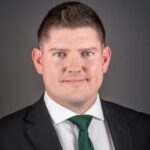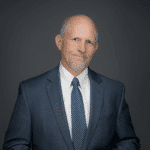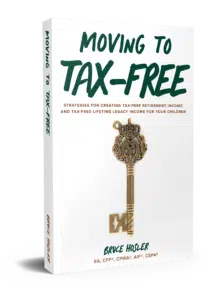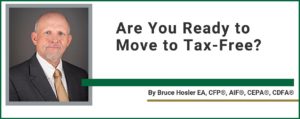In this episode of “Protecting and Preserving Wealth,” we delve into the significance of moving financial assets to tax-free vehicles, a topic I have extensively explored in my new book, “MOVING TO TAX-FREE™.” Alongside Jason Hosler and host Jon Jag Gay, we discuss the critical nature of planning for a tax-free retirement, emphasizing the importance of strategic financial planning to mitigate future tax burdens.
The central question is whether tax rates in the United States will increase, decrease, or remain the same over the next decade. This question is pivotal as it directs individuals on planning their financial futures. I argue that, rather than political, tax rates will likely double in the next ten years due to mathematical and scientific reasons. The impending insolvency of Medicare and Social Security trust funds, the national debt crisis exacerbated by inflation and higher interest rates, and comparing U.S. tax rates to those of other developed countries supports this prediction.
The discussion then shifts to the common but misguided question many people ask about minimizing taxes in the current year rather than focusing on reducing lifetime tax liabilities. I underscore the importance of annual tax planning and the power of making informed decisions about moving assets to tax-free accounts, such as Roth IRAs and 401(k)s. Paying taxes now, at current lower rates, can help prevent paying higher taxes in the future, putting you in control of your financial destiny.
The conversation also touches on the reluctance of the financial advisory industry to promote moving to tax-free accounts due to potential conflicts of interest, as advisors’ fees are often based on the assets under management, which would decrease as clients pay taxes on conversions to tax-free accounts.
I offer practical advice for listeners to start their journey toward a tax-free retirement, including stopping contributions to traditional tax-deferred accounts and beginning to contribute to Roth accounts. I also address concerns about the government potentially taxing Roth accounts in the future, arguing that historical precedents suggest that existing accounts would likely be grandfathered in should any changes occur.
In conclusion, I present innovative legacy planning strategies detailed in the book – a plan I call “The Two Generation Tax-Free Legacy Plan”™ – designed to provide a tax-free income stream for children and protect assets from potential legal and financial threats.
To purchase your copy of Bruce’s book, visit https://movingtotaxfree.com/
For more information about anything related to your finances, contact Bruce Hosler and the team at Hosler Wealth Management.
Call the Prescott office at (928) 778-7666 or our Scottsdale office at (480) 994-7342.
To listen to more Protection & Preserving Wealth podcast episodes, click here.
Limitation of Liability Disclosures: https://www.hoslerwm.com/disclosures/#socialmedia
Guest Profile

Jason Hosler holds Series 7 and 66 FINRA securities registrations. He brings a technological edge to our firm and helps many of our clients stay current in the fast-moving age of the internet.
Podcast Host

Bruce Hosler is the founder and principal of Hosler Wealth Management, LLC., which has offices in Prescott and Scottsdale, Arizona. As an Enrolled Agent, CERTIFIED FINANCIAL PLANNER™ professional, and Certified Private Wealth Advisor (CPWA®), Bruce brings a multifaceted approach to advanced financial and tax planning. He is recognized as a prominent financial professional with over 27 years of experience and a seven-time consecutive *Forbes Best-In-State Wealth Advisor in Arizona. Bruce recently authored the book MOVING TO TAX-FREE™ Strategies For Creating Tax-Free Retirement Income And Tax-Free Lifetime Legacy Income For Your Children. www.movingtotaxfree.com.
In the Protecting & Preserving Wealth podcast, Bruce and his guests discuss current financial topics and provide timely answers for our listeners.
If you have a topic of interest, please let us know by emailing info@hoslerwm.com. We welcome your suggestions.
*2018-2024 Forbes Best In State Wealth Advisors, created by SHOOK Research. Presented in April 2024 based on data gathered from June 2022 to June 2023. 23,876 were considered, 8,507 advisors were recognized. Not indicative of advisor’s future performance. Your experience may vary. For more information, please visit.
Transcript
Jon Jag Gay: Welcome to Protecting and Preserving Wealth. I’m Jon Jag Gay. I’m joined by Bruce and Jason Hosler as always today. The anticipation today is pretty exciting. We’ve had, in previous podcasts, Bruce give us a ton of knowledge about moving to tax-free. So much in fact that he could write a book about it, and well, he has. The book is now out, “MOVING TO TAX-FREE™.” It’s out to the public. Congratulations, Bruce. You must be really excited.
Bruce Hosler: Jon, I am very excited to bring this big project to a conclusion, and I’m happy that we finally arrived at this point where I can bring this book to light and to the public.
Jason Hosler: Jon, this has been Bruce’s life work. Helping our clients strategically move their financial planning and assets to tax-free vehicles. It’s very rewarding to see our clients enjoy the fruit of our labors as they close in on being able to live a tax-free retirement.
Jon: Again, in previous episodes of the podcast, we’ve talked about several examples of situations where you’ve helped clients move to tax-free. Bruce, what do you want to share about the book just for starters here?
Bruce: Jon, I start the first chapter of the book with the title of the chapter, The Most Important Question.
Jon: All right then, Bruce. What is the most important question?
Bruce: The most important question is, if you look forward into the future of the United States over the next 10 years, do the tax rates stay the same, do they go lower, or do they go higher? Now, when I ask that question, it’s very important because the answer determines what people should be doing from that point forward. Because the answer, one way or the other, is a big directional change.
Jon: I assume the next question then, Bruce, is why? Why would they believe tax rates are going to stay the same, go lower, or go higher?
Bruce: That’s right, Jon. I want to know why they believe that the tax rates are going higher or going lower, and because the answer is not a political answer, and sometimes some of them think that it is. It’s a matter of math and science and not politics. Let me explain why.
Jon: Okay.
Bruce: There’s a lot of experts that believe that the tax rates in the United States will have to likely double in the next 10 years. I did say double. So, if you’re paying 25% today, they’re likely to double to 50% in the next 10 years. Now, the why, the reason behind that is actually something that people should know about. Many people may not know. Let me just identify some of the items in the book that I provide as proof of that. The Medicare trust fund runs out of money in 2028.
It doesn’t mean that it runs out of funds altogether. It just means the extra money that’s in the trust fund that’s being consumed today will run out, and they’re going to have to find that additional revenue somewhere else. Social Security trust fund runs out in 2033. If they don’t make any changes, everyone’s going to take a 23% cut in their Social Security benefits. I’m sure a lot of senior citizens are going to be happy about that. Certainly, everybody looks at our national debt, right?
At the record highs that that is, but that is affected dramatically by the inflation we’re seeing right now, and the inflation affects the interest rates that the fed has raised to, so now we have to pay this high national debt on higher interest rates that have skyrocketed. So the interest we’re going to have to pay on the national debt is squeezing all of the other budget items until something dramatic will have to happen. That dramatic is probably going to be higher tax rates.
Then finally, if you just look around the rest of the developed world, most of them are paying 42% to 55% roughly in taxes. In the United States, we’re paying much less than that. So, likely, we’re going to have to catch up with the rest of the world at some point.
Jason: Jon, as tax professionals, we get the same questions that most other tax professionals get every year. What can I do so I don’t have to pay so much tax this year? It’s just the wrong question.
Jon: What is the question they should be asking you?
Bruce: The question they should be asking is, what can I do to pay the least amount of taxes over my lifetime? Not just this year.
Jon: Okay. Follow-up to that, Bruce. Does that mean that people are going to have to pay more taxes up front?
Bruce: Not necessarily, but they need to start strategically planning. Let me give you some steps that are important. Every year, they should be preparing an annual tax plan to know and control which tax bracket they’re going to fall into. You plan your move to tax-free with full awareness of the effective tax rate that you’ll be on, or be in, when you make your move to tax-free. Because you’re in control of that tax rate, you get to choose the rate at which you’ll lock in all of your taxable income for that year. Each year, you can assume that your income will never be able to be taxed at twice the rate, say 50% in the future, because you’ve already moved it to tax-free.
Given the facts, and when provided with the opportunity to be in control, we have found that most people wisely choose to pay a little bit more tax right now so that their tax rates are going to be locked in on these low tax rates we have that are on sale right now.
Jon: I like the term on sale. A moment ago, Bruce, you used the term effective tax rate. I’ve heard marginal tax rate. What’s the difference between those two tax rates?
Bruce: In 2024 right now, the tax brackets are 10%, 12%, 22%, 24%, 32%, 35%, and finally, 37%. Those are all marginal tax brackets. Your marginal tax bracket is, if your boss gives you a pay raise and you earn one more dollar, what will that dollar be taxed at? It’s your next marginal dollar of income. It also applies to you if you make a Roth conversion. If you’ve earned all your money that year and you convert one more dollar to a Roth, it will be taxed at your next marginal rate, but only that dollar.
Now, your effective tax rate is the rate of all of those brackets, the dollars that were taxed at 10%, the dollars that were taxed at 12%, the dollars that were taxed at 22, all of that combined and added up and averaged across your income, that’s your effective tax rate. The effective tax rate is the rate you actually pay as a percentage of all of your income.
Jason: There are a lot of benefits in keeping your taxable income low as you enter retirement.
Jon: Like what?
Jason: One of our goals is to help people avoid paying IRMAA. Those are the Medicare premium penalties. IRMAA is, income-related monthly adjustment amount. It is another bracket, separate from the tax brackets that as you go up and you make more money, you get charged more for your Medicare premium every month. Those penalties can range from $244 to as much as $594 per month per person for married filing joint filers. Those penalties get subtracted from your Social Security benefits.
We also try and help people to avoid paying income tax on their Social Security benefits. Taxing your Social Security benefits, if you could have avoided that with proper planning, we want people to take advantage of moving to tax-free, so they can do that if possible.
Jon: As always, and again, it’s consistent with the previous episodes to the podcast we’ve done, gentlemen, the information here is very compelling. Why aren’t we hearing about this from other financial advisors and institutions, guys?
Bruce: Jon, think about it. How are most financial advisors and financial institutions compensated? How do they earn their pay? I would say the vast majority in the industry work on a fee basis on their accounts. The more money you have with them, they get a fee on it.
Jon: Okay.
Bruce: Just imagine, if some of your investments are invested in an IRA, and in order to make the move to tax-free, you have to pay the taxes on that conversion amount. Let’s just say you have $100,000 in your IRA, and you want to convert it, and you’re in the 30% tax bracket. You’ll pay 30% of that $100,000, or $30,000 of it in taxes. Now, your advisor will lose the fees on that $30,000, or that 30% that you’re paying the taxes on your investments that they used to be able to make a fee on. As you make your move to tax-free, you have to pay the taxes.
Now, think about it. They might be subject to a reduction as much as a 30% of their fees. Do you think there’s any motivation for the fee-based advisory world to help you make the move to tax-free? Even if it’s in your best interest, over your remaining life to do that, they say they’re fiduciaries, but it’s a conflict of interest that’s very big for them, and you don’t hear them talking about this at all.
Jason: Jon, people are generally really averse to paying tax before they’re required to do so.
Jon: Sure.
Jason: The industry has promoted the tax-deferred vehicles for so long. That’s why it’s important to create an overall plan on how to move to tax-free. Clients need to see that there is a multi-year plan that is going to get them to the end goal that we have in mind. Each step of the way, each year you have a tax plan in hand, you control the rate of taxes that you pay. People aren’t opposed to paying taxes sooner if they’re in control, they know exactly what the tax rate is that they’re going to be paying, they have a long-term plan in order to make their move to tax-free.
Jon: If there’s one piece of advice you could give our listeners today to help them start making this move to tax-free, Bruce, what would it be?
Bruce: I’ll give them two ideas that they can implement right away. The first one is, stop digging the hole deeper. When you’re in a hole, they say the first thing to do is stop digging deeper. If you’re funding a traditional 401(k), in almost all cases, it makes sense for you to stop that. Instead, I want you to make sure that you switch over and start contributing to a Roth 401(k), if you have that available at your work. Number two, they can go purchase a copy of my book and begin reading or listening on Audible, to see if they can implement the other steps that I have in the book to move to tax-free.
Jon: Jason, you ever get people that are fearful that the government may come back and tax their Roth and 401(k) accounts a second time?
Jason: Jon, that’s a good question. I would invite our listeners to consider, is it any easier for the government to raise taxes on everyone to cover the shortfall, or to really upset the people that have already paid their taxes with a Roth conversion?
Jon: Fair enough. Okay.
Jason: Yes. Historically, when the government stops allowing something like the Roth, they will grandfather in everyone that has already had one. We saw that a couple of years ago with the changes that they made to Social Security. In other words, they’re going to stop allowing people to set up a new one, but if you already have one, then you’ll be allowed to keep it and use it. We’ve seen that time and time again, over the last 27 years in tax law. We expect that should that ever happen, it would be grandfathered in. Just think about it. The governments love you to convert your IRA to a Roth.
They get their taxes now. They don’t have to wait 20 or 30 years until you’re ready to pull it out in retirement. It pulls those tax dollars forward in time when the government really needs tax dollars. We understand people are fearful, but we don’t believe it’s a realistic possibility. There’s too many other ways the government can generate additional tax revenue in other low hanging fruit.
Jon: Makes sense. The government gets the money now, and you’re not stuck paying the bill later. In some ways, it seems like a win-win.
Jason: Right.
Jon: I know many parents are concerned for their children, and what this world is going to be like in 20, 30 years, with the revelation that it’s likely tax rates could be twice as much as they are today, as Bruce mentioned earlier. Many parents are going to worry about what can be done for their kids, right?
Bruce: Jon, in my book, “MOVING TO TAX-FREE™,” I am introducing some new legacy planning strategies that will allow parents to provide a tax-free legacy that includes a lifetime income stream for their children. We call it, “The Two Generation Tax-Free Legacy Plan.”™ Now, this legacy income stream will usually be asset protected from divorce of your children, bankruptcies, car accidents, or business failures that they may get in, or any other creditors they may have.
This can provide families with the ability to leave a portion of their inheritance to their children that’s asset protected, provides a lifetime tax-free income stream, and will even leave a tax-free benefit to the grandchildren in the end. There’ll be plenty of other funds that will be left to the kids as a lump sum at your passing, but if you desire to leave some of your funds as a tax-free income stream for your children, we have strategies that will allow our clients to do that.
Jon: Bruce, if listeners want to purchase the new book, again, congratulations on publishing it and getting it out, where can they find it?
Bruce: They can find it on Amazon, for the physical and the digital book, and on Audible for the recording. They can also purchase it on my website, at www.movingtotaxfree.com. If they want to buy copies in bulk, like to give as gifts to friends or family, those details are available on the website there, at movingtotaxfree.com.
Jon: We’ll also have that link in the show notes for this episode in case you’re driving and not able to jot that down while you’re listening. Jason, meanwhile, as far as Hosler Wealth Management, if anyone wants to get in touch with you and the team, how do they best do that?
Jason: They can always reach out to us at our website, https://hoslerwm.com.
Jon: Okay. Once again, Bruce, congratulations on the book. I’m sure I can speak for all our listeners. We look forward to learning more as we have in the podcast.
Bruce: Thanks, Jon.
Jason: Thank you, Jon.
Jon: Securities and advisory services offered through Commonwealth Financial Network, member FINRA/SIPC, a registered investment advisor. Forward-looking commentary should not be misconstrued as investment or financial advice. The advisor associated with this podcast is not monitored for comments, and any comments should be given directly to the office at the contact information specified.
Any tax advice contained in this communication, including any attachments, is not intended or written to be used and cannot be used for the purpose of, 1) avoiding federal or state tax penalties, or two, promoting, marketing, or 2) recommending to another party any transaction or matter addressed herein. The accuracy, completeness, and timeliness of the information contained in this podcast cannot be guaranteed. Accordingly, Hosler Wealth Management LLC does not warranty, guarantee, or make any representations or assume any liability with regard to financial results based on the use of the information in this podcast.
Comments are closed.



